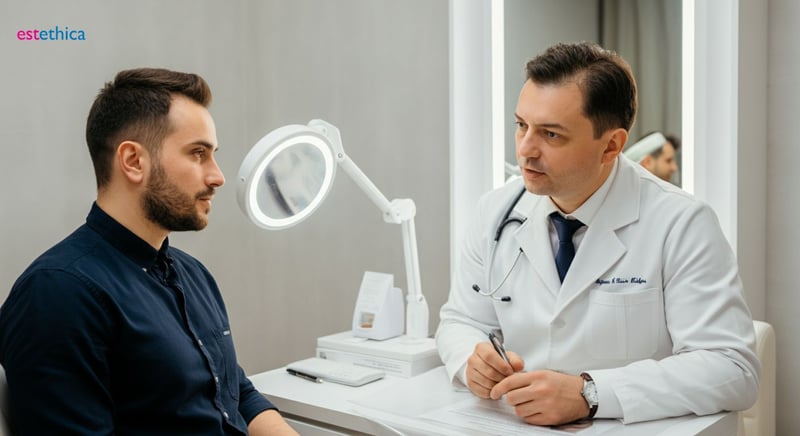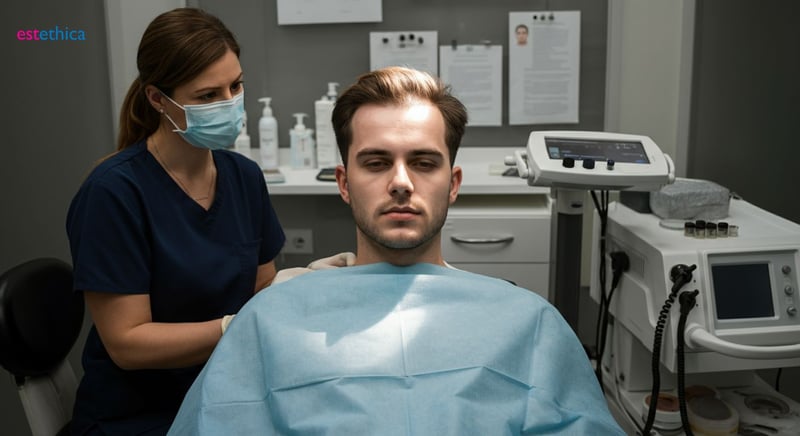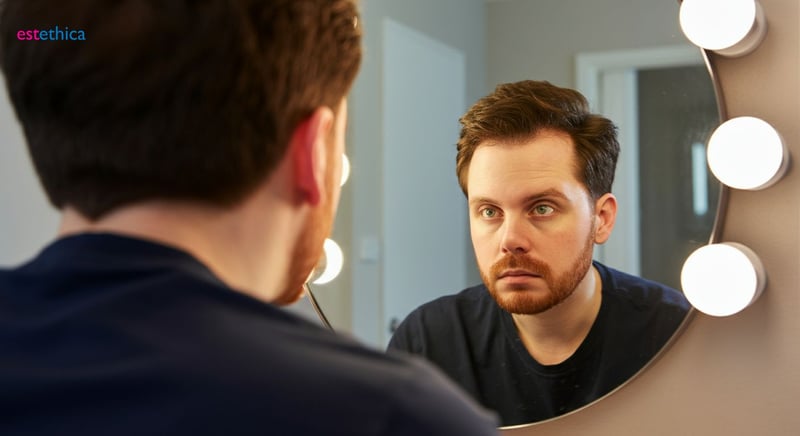Hair Today, More Tomorrow: Your Guide to Hair Transplantation
Rediscover confidence with our comprehensive guide to hair transplantation. Learn about modern techniques and what you can expect during recovery.
Hair transplantation has evolved into a precise science, offering hope to those grappling with hair loss. In this guide, we uncover everything you need to know from understanding hair loss to choosing the right transplant method, and what recovery entails. Whether you're considering a follicular unit extraction or a direct hair implantation, this guide will navigate you through every step.
Understanding Hair Loss: Is a Hair Transplant Right for You?
Exploring the Impact of Hair Loss
Hair loss can profoundly affect individuals, with repercussions extending beyond mere physical appearance. The psychological impact, stemming from reduced self-esteem, can influence social interactions and overall life satisfaction. Understanding the causes and exploring available hair loss treatment options are essential steps for those experiencing thinning hair. Addressing the emotional aspects alongside finding suitable solutions is vital in restoring confidence.
- Self-Perception: Hair loss can lead to feelings of aging and reduced attractiveness, affecting how individuals view themselves.
- Social Anxiety: Concerns about appearance may result in increased social anxiety and avoidance of public situations.
- Emotional Well-being: Feelings of depression or sadness can arise from the perceived loss of control over one's physical appearance.
Determining if a Hair Transplant Is a Suitable Option
Deciding whether a hair transplant is the right approach involves evaluating various factors, including the type and extent of hair loss, the individual's overall health, and personal expectations. Options for hair restoration have developed, and procedures like FUE hair transplant now provide natural-looking results with shorter hair transplant recovery time. A comprehensive assessment by a qualified specialist such as estethica Global can help determine the most appropriate path forward. Considering advanced techniques is also crucial for making an informed decision.
- Initial Consultation: A thorough examination by a hair restoration specialist to assess your specific condition and discuss potential outcomes.
- Health Evaluation: Ensuring that you are medically fit for the procedure, which includes evaluating factors like age and pre-existing conditions.
- Realistic Expectations: Understanding what a hair transplant can achieve and aligning your expectations with possible results.

FUE Hair Transplant: The Modern Approach to Hair Restoration
Advantages of Follicular Unit Extraction
Follicular Unit Extraction (FUE) offers several advantages over traditional hair restoration methods, making it a popular choice for individuals seeking natural-looking hair restoration. FUE involves extracting individual hair follicles directly from the scalp, which minimizes scarring and eliminates the need for a large incision. This technique allows for a quicker hair transplant recovery time and reduces discomfort, providing a more convenient experience.
- Minimal Scarring: FUE leaves tiny, almost imperceptible scars, allowing patients to wear shorter hairstyles without concern.
- Reduced Discomfort: Because FUE is less invasive, patients typically experience less pain and discomfort during and after the procedure.
- Natural Results: The precise extraction and placement of individual follicles result in a more natural-looking hairline and overall hair density.
The FUE Procedure: Step-by-Step
The FUE hair transplant procedure involves several key steps to ensure successful hair restoration. First, the donor area is prepared and numbed using local anesthesia. Then, individual follicles are extracted using a specialized micro-punch tool. These follicles are carefully implanted into the recipient area, following the natural hair growth pattern to achieve optimal density and a seamless appearance. The result is a fuller, more youthful-looking head of hair.
- Extraction: Follicular units are extracted one by one from the donor area using a precision tool, minimizing damage to the scalp.
- Preparation: The extracted grafts are prepared under magnification, ensuring they are healthy and ready for implantation.
- Implantation: The grafts are carefully placed into small incisions in the recipient area, following the natural angle and distribution of hair growth.

The Hair Transplant Recovery Timeline: What to Expect Day by Day
Immediate Post-Op Care: Setting the Stage for Recovery
The initial phase following a hair transplant is crucial for ensuring the success of the procedure and managing expectations regarding the hair transplant recovery time. Directly after the surgery, it's normal to experience some swelling and redness in both the donor and recipient areas. Pain management is typically addressed with prescribed or over-the-counter medications, and it's essential to keep the scalp clean to prevent infection. How you manage this immediate period significantly influences the overall healing process and the eventual outcome.
- Gentle Cleansing: Use a mild, fragrance-free shampoo as directed by your surgeon to keep the scalp clean without irritating the newly implanted follicles.
- Avoid Strenuous Activity: Refrain from any activities that could cause sweating or strain on the scalp for at least two weeks post-surgery.
- Sleep Position: Elevate your head with extra pillows to minimize swelling during the first few nights after the procedure.
Navigating the Weeks Following Your Hair Transplant
As you progress through the weeks following your hair transplant at locations such as estethica Global, you'll begin to notice gradual changes and improvements. While some of the transplanted hair may shed initially—a process known as shock loss—new growth will start to emerge over the following months. Adhering to a consistent hair restoration aftercare routine, including recommended medications and avoiding direct sun exposure, will support optimal follicle integration and growth. Regular follow-up appointments with your surgeon will also aid in monitoring progress and addressing any concerns that may arise.
- Consistent Medication: Continue any prescribed medications, such as DHT blockers, to help stabilize existing hair and promote the growth of transplanted follicles.
- Sun Protection: Protect your scalp from direct sun exposure by wearing a hat or using sunscreen to prevent damage to the new grafts.
- Nutrient-Rich Diet: Maintain a healthy diet rich in vitamins and minerals to support overall hair health and promote faster growth.

Beyond the Procedure: Long-Term Hair Loss Treatment and Maintenance
Sustaining Your Hair Restoration
Maintaining the results of a hair transplant involves several key strategies designed to promote long-term hair health. Regular follow-up appointments with specialists at clinics like estethica Global are crucial for monitoring progress and adjusting treatment plans as needed. Adopting a scalp care regimen, including the use of appropriate shampoos and conditioners, can help support the vitality of transplanted follicles. In fact, about 85% of patients who adhere to a consistent aftercare plan experience better long-term results. These efforts, combined with a healthy lifestyle, significantly contribute to extending the benefits of the procedure.
- Regular Check-ups: Scheduled visits to your hair restoration specialist enable early detection of any issues and timely intervention.
- Scalp Care: Proper cleansing and conditioning maintain a healthy scalp environment, fostering optimal hair growth.
- Lifestyle Adjustments: A balanced diet and stress management techniques can positively impact hair health and longevity.
Strategies for Prolonging Hair Health After a Hair Restoration
To maximize the longevity of your hair transplant , incorporate effective strategies into your daily routine. The use of DHT blockers, prescribed by your doctor, helps to slow down or prevent further hair loss. Additionally, consider incorporating non surgical hair restoration options such as laser therapy and PRP (platelet-rich plasma) treatments to stimulate follicle growth and scalp health. Protecting your hair from excessive sun exposure and avoiding harsh styling practices also contribute to maintaining healthy, vibrant hair. Embracing these practices supports the enduring success of your FUE hair transplant.
- Medication Compliance: Following your doctor's recommendations regarding DHT blockers can significantly slow down future hair loss.
- Advanced Treatments: Integrating therapies like laser therapy and PRP can rejuvenate hair follicles, promoting growth and density.
- Protective Measures: Shielding your hair from the sun and avoiding harsh chemicals minimizes damage and supports long-term health.
FUE and DHI for Natural-Looking Hair Restoration
Personalized Hair Restoration and Aftercare for Optimal Results
Frequently Asked Questions
What is a FUE hair transplant and how does it differ from traditional methods?
What can I expect during the hair transplant recovery time, and how can I ensure the best results?
How can I maintain the results of my hair restoration in the long term?
Is a hair transplant a suitable option for all types of hair loss, and how is this determined?
Achieve your aesthetic goals with estethica's world-class services and expert team.
📞 Call Now for a Free Consultation!